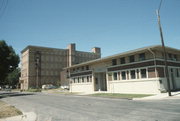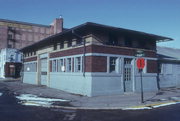Property Record
101 N BLOUNT ST
Architecture and History Inventory
| Historic Name: | City Market |
|---|---|
| Other Name: | apartments |
| Contributing: | |
| Reference Number: | 16069 |
| Location (Address): | 101 N BLOUNT ST |
|---|---|
| County: | Dane |
| City: | Madison |
| Township/Village: | |
| Unincorporated Community: | |
| Town: | |
| Range: | |
| Direction: | |
| Section: | |
| Quarter Section: | |
| Quarter/Quarter Section: |
| Year Built: | 1909 |
|---|---|
| Additions: | |
| Survey Date: | 1983 |
| Historic Use: | large retail building |
| Architectural Style: | Prairie School |
| Structural System: | |
| Wall Material: | Brick |
| Architect: | Robert L. Wright |
| Other Buildings On Site: | |
| Demolished?: | No |
| Demolished Date: |
| National/State Register Listing Name: | City Market |
|---|---|
| National Register Listing Date: | 11/28/1978 |
| State Register Listing Date: | 1/1/1989 |
| National Register Multiple Property Name: |
| Additional Information: | A 'site file' exists for this property. It contains additional information such as correspondence, newspaper clippings, or historical information. It is a public record and may be viewed in person at the Wisconsin Historical Society, Division of Historic Preservation. The map code is 0709-133-0108-5. Commissioned by the city in 1909 in an early effort at civic improvement during the City Beautiful movement. The deisgns for the market, created by Robert L. Wright, is an unusual, non-residential example of the style. As a municipally owned farmers' market, the City Market reflected two Progressive Era impulses: a trend toward ever-expanding municipal services and the nationwide City Beautiful Movement to enhance urban aesthetics. It replaced the informal and, some felt, unsightly stands that individual farmers set up every day along the downtown streets to peddle their produce. When critics labeled the new market "socialistic," Mayor Joseph Schubert responded that "if bringing the government closer to the needs of the people was socialistic it was just what the people were entitled to." As the building was going up, the Wisconsin State Journal praised its design as "the most artistic piece of property owned by the city." The architect, who had apprenticed with Claude and Starck, produced a Prairie style building, which emphasizes low-pitched hipped roofs with wide overhanging eaves that cast deep shadows across the walls. Windows form horizontal bands, and belt courses wrap around the building to define ribbons of cream and red brick. A driveway originally ran through the building so that farmers could unload their wagons under the shelter of the roof. The building also incorporated a lounge for women and a smoking room for men--a gendered segregation of public spaces that was common for the day. The Alexander Company rehabilitated the market into an apartment building, one of many efforts to foster a vibrant downtown by encouraging people to live there. Architecture Network, Inc., The Arts & Crafts Movement: A Conference, October 23 & 24, 1999. Madison Landmark: 7/18/1976. |
|---|---|
| Bibliographic References: | Old Market Place Neighborhood walking tour guide. Madison Landmarks Commission and Old Market Place Neighborhood Association, 1991. Wisconsin State Journal 5/24/2003 Section C. Buildings of Wisconsin manuscript. Architecture Network, Inc., The Arts & Crafts Movement: A Conference, October 23 & 24, 1999. |
| Wisconsin Architecture and History Inventory, State Historic Preservation Office, Wisconsin Historical Society, Madison, Wisconsin |





